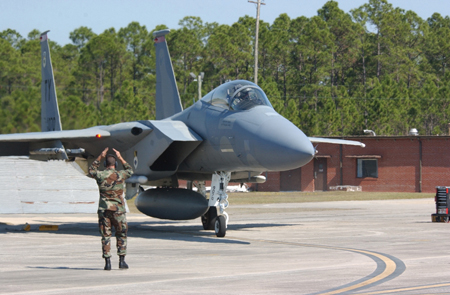 It was instructor pilot “War Day” at Tyndall AFB, Fla., recently, with F/A-22 and F-15 instructors flying against F-16 instructors and a QF-4 drone in a mock aerial engagement. It was the first time, said Air Force officials, that the F/A-22s had paired with other aircraft for an engagement. There were two F/A-22s, 12 F-15s, and one KC-135 on the Blue force and 18 F-16s, two KC-135s, and the drone on the Red. To complicate matters, though, the Red team got to reuse its aircraft even after they were “shot down” to simulate a massive enemy force. The Blue force mission was to protect a simulated high-value target near Carrabelle, Fla. To add to the realism, the exercise also included intelligence, air battle management, and maintenance personnel. We don’t know who won. The Air Force doesn’t like to say, but officials did say the Blue force scored 22 kills.
It was instructor pilot “War Day” at Tyndall AFB, Fla., recently, with F/A-22 and F-15 instructors flying against F-16 instructors and a QF-4 drone in a mock aerial engagement. It was the first time, said Air Force officials, that the F/A-22s had paired with other aircraft for an engagement. There were two F/A-22s, 12 F-15s, and one KC-135 on the Blue force and 18 F-16s, two KC-135s, and the drone on the Red. To complicate matters, though, the Red team got to reuse its aircraft even after they were “shot down” to simulate a massive enemy force. The Blue force mission was to protect a simulated high-value target near Carrabelle, Fla. To add to the realism, the exercise also included intelligence, air battle management, and maintenance personnel. We don’t know who won. The Air Force doesn’t like to say, but officials did say the Blue force scored 22 kills.
The Space Force’s Combat Forces Command is expanding its footprint with the creation of two new operations hubs for electronic warfare and satellite communications.

